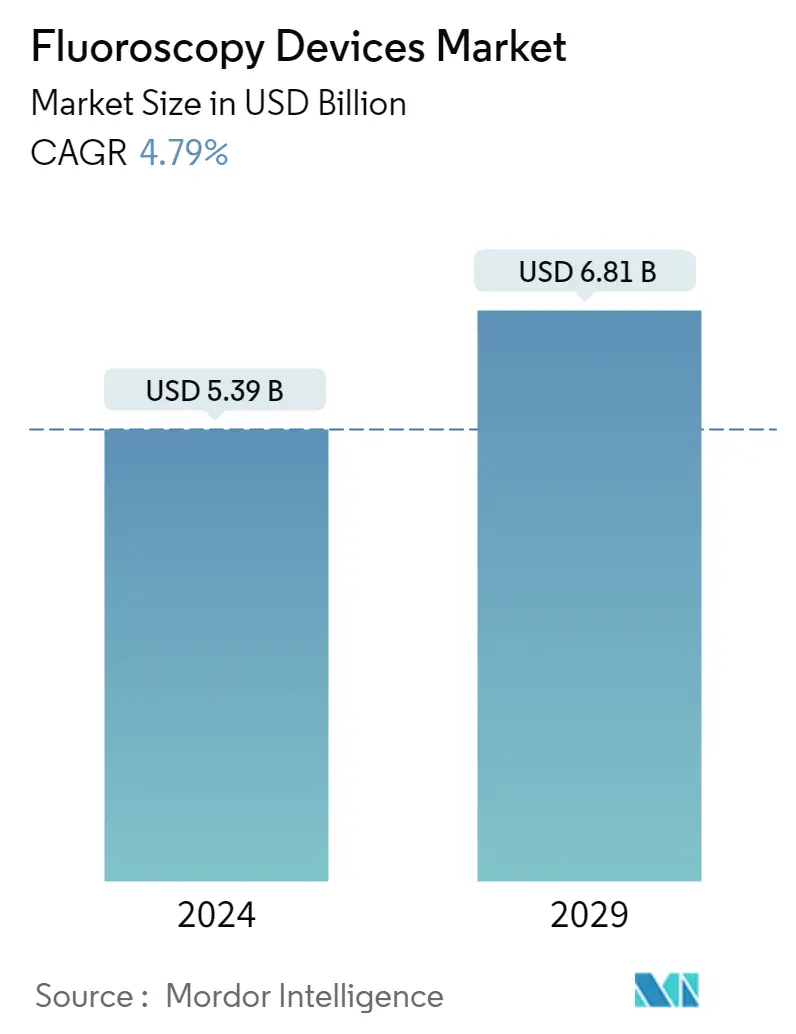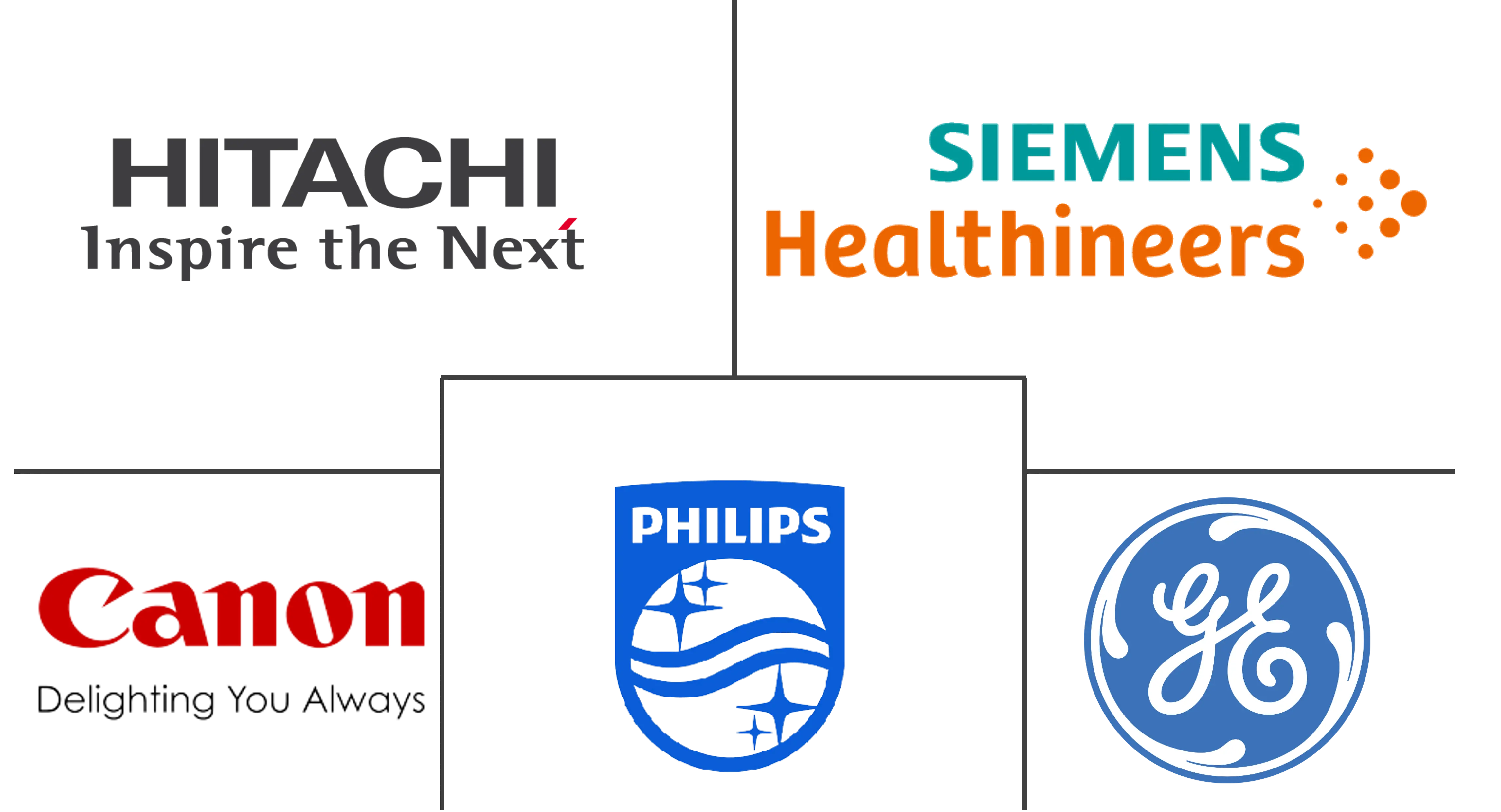Market Size of Fluoroscopy Devices Industry

| Study Period | 2019 - 2029 |
| Market Size (2024) | USD 5.39 Billion |
| Market Size (2029) | USD 6.81 Billion |
| CAGR (2024 - 2029) | 4.79 % |
| Fastest Growing Market | Asia-Pacific |
| Largest Market | North America |
| Market Concentration | Medium |
Major Players
*Disclaimer: Major Players sorted in no particular order |
Fluoroscopy Devices Market Analysis
The Fluoroscopy Devices Market size is estimated at USD 5.39 billion in 2024, and is expected to reach USD 6.81 billion by 2029, growing at a CAGR of 4.79% during the forecast period (2024-2029).
COVID-19 had a significant impact on the fluoroscopy devices market since a lot of diagnostic centers were shut down due to the lockdown. For instance, as per the article published in August 2021 by PubMed, the COVID-19 period was linked to a decrease in radiological outpatient activity. Several variables, including parental fear about traveling during a lockdown, their children's perceived well-being, an increase in mental health issues, or difficulty coping with ordinary tasks, root the reason for the decreased radiological outpatient activity. However, since the restrictions were eased, the sector has been recovering strongly. Over the last two years, increased fluoroscopy device sales, new product launches, and increased demand for minimally invasive surgeries have led the market recovery.
The fluoroscopy devices market is primarily driven by the rising prevalence of chronic diseases and the increasing use of fluoroscopy in pain management. The increase in the aging population and changes in societal behavior are contributing to a steady rise in these common and costly long-term health problems. According to the American Cancer Society Cancer Facts and Figures 2022 report, the estimated numbers of new cancer cases are likely to be 1.9 million in the United States. The most affected would be the emerging markets, as population growth is anticipated to be most significant in developing areas. Furthermore, the use of fluoroscopy in pain management is expected to supplement the development of the market. For instance, as per the article published in April 2022 by PubMed, C-arm fluoroscopy is a beneficial tool for interventional pain management. Furthermore, a suitable fluoroscopic mode (pulsed mode, low dose mode), collimation, and a laser aiming line are beneficial in lowering patient and physician exposure to the primary X-ray beam and scattered radiation.
Furthermore, the rising demand for minimally invasive surgery and the growing geriatric population are the main factors boosting the market growth. For instance, an article published in March 2022 in BMC journal stated that the confidence of surgeons in minimally invasive techniques is higher for simple surgical interventions such as appendectomy, cholecystectomy, and abdominal exploration. Furthermore, per the WPP 2022, the share of the global population aged 65 years or above is projected to rise from 10% in 2022 to 16% in 2050.
Hence, considering the factors mentioned above. The fluoroscopy devices market is anticipated to witness growth over the forecast period. However, the side effects of radiation and the rising adoption of refurbished systems are expected to hinder market growth over the forecast period.
Fluoroscopy Devices Industry Segmentation
According to the scope of the report, fluoroscopy is an imaging technique that uses X-rays to produce real-time images of internal organs. Unlike X-ray images, fixed still images on film, fluoroscopy produces live-moving pictures of internal organs, which the naked eye on a digital monitor can view. A typical fluoroscope has four components: an X-ray source, an X-ray image intensifier, an imaging system, and a workstation. A C-arm is an X-ray image intensifier. It is a C-shaped metal arm with an X-ray source fixed on one end and an X-ray image intensifier fixed on the other. The fluoroscopy devices market is segmented by device type (fixed fluoroscopes and mobile fluoroscopes), application (orthopedic, cardiovascular, pain management and trauma, neurology, gastrointestinal, urology, general surgery, and other applications), and geography (North America, Europe, Asia-Pacific, South America, and Middle East and Africa). The market report also covers the estimated market sizes and trends for 17 countries across major regions globally. The report offers the value (in USD million) for the above segments.
| By Device Type | ||||
| Fixed Fluoroscopes | ||||
|
| By Application | |
| Orthopedic | |
| Cardiovascular | |
| Pain Management and Trauma | |
| Neurology | |
| Gastrointestinal | |
| Urology | |
| General Surgery | |
| Other Applications |
| By Geography | ||||||||
| ||||||||
| ||||||||
| ||||||||
| ||||||||
|
Fluoroscopy Devices Market Size Summary
The fluoroscopy equipment market is poised for growth, driven by the increasing prevalence of chronic diseases and the rising demand for minimally invasive surgeries. The market has shown resilience in the wake of the COVID-19 pandemic, which initially caused a decline in radiological outpatient activity due to lockdowns and health concerns. However, the easing of restrictions has led to a resurgence in demand, fueled by new product launches and the growing use of fluoroscopy in pain management. The aging population and societal changes are contributing to the rise in chronic health issues, further propelling the market. The cardiovascular segment, in particular, is expected to experience significant growth due to the high prevalence of cardiovascular diseases and the need for fluoroscopic guidance in procedures like cardiac catheterization.
North America is anticipated to be a key region for market expansion, supported by a robust healthcare infrastructure and active participation from major market players in technological advancements. The United States, with its increasing number of diagnostic procedures and technological innovations, is expected to contribute significantly to the market. The presence of major players such as Canon Medical Systems, GE Healthcare, and Siemens Healthineers, along with recent product launches and regulatory approvals, underscores the competitive landscape. Despite the market's moderate consolidation, these companies are focusing on reducing procedural side effects and enhancing imaging capabilities, which is likely to drive further growth in the fluoroscopy equipment market over the forecast period.
Fluoroscopy Devices Market Size - Table of Contents
-
1. MARKET DYNAMICS
-
1.1 Market Overview
-
1.2 Market Drivers
-
1.2.1 Rising Demand for Minimally-invasive Surgeries
-
1.2.2 Growing Geriatric Population and Prevalence of Chronic Diseases
-
1.2.3 Increasing Use of Fluoroscopy in Pain Management
-
-
1.3 Market Restraints
-
1.3.1 Side Effects and Radiation Exposure
-
1.3.2 Rising Adoption of Refurbished Systems
-
-
1.4 Porter's Five Forces Analysis
-
1.4.1 Threat of New Entrants
-
1.4.2 Bargaining Power of Buyers/Consumers
-
1.4.3 Bargaining Power of Suppliers
-
1.4.4 Threat of Substitute Products
-
1.4.5 Intensity of Competitive Rivalry
-
-
-
2. MARKET SEGMENTATION (Market Size by Value - USD Million)
-
2.1 By Device Type
-
2.1.1 Fixed Fluoroscopes
-
2.1.2 Mobile Fluoroscopes
-
2.1.2.1 Full-size Fluoroscopes
-
2.1.2.2 Mini Fluoroscopes
-
-
-
2.2 By Application
-
2.2.1 Orthopedic
-
2.2.2 Cardiovascular
-
2.2.3 Pain Management and Trauma
-
2.2.4 Neurology
-
2.2.5 Gastrointestinal
-
2.2.6 Urology
-
2.2.7 General Surgery
-
2.2.8 Other Applications
-
-
2.3 By Geography
-
2.3.1 North America
-
2.3.1.1 United States
-
2.3.1.2 Canada
-
2.3.1.3 Mexico
-
-
2.3.2 Europe
-
2.3.2.1 Germany
-
2.3.2.2 United Kingdom
-
2.3.2.3 France
-
2.3.2.4 Italy
-
2.3.2.5 Spain
-
2.3.2.6 Rest of Europe
-
-
2.3.3 Asia-Pacific
-
2.3.3.1 China
-
2.3.3.2 Japan
-
2.3.3.3 India
-
2.3.3.4 Australia
-
2.3.3.5 South Korea
-
2.3.3.6 Rest of Asia-Pacific
-
-
2.3.4 Middle East and Africa
-
2.3.4.1 GCC
-
2.3.4.2 South Africa
-
2.3.4.3 Rest of Middle East and Africa
-
-
2.3.5 South America
-
2.3.5.1 Brazil
-
2.3.5.2 Argentina
-
2.3.5.3 Rest of South America
-
-
-
Fluoroscopy Devices Market Size FAQs
How big is the Fluoroscopy Devices Market?
The Fluoroscopy Devices Market size is expected to reach USD 5.39 billion in 2024 and grow at a CAGR of 4.79% to reach USD 6.81 billion by 2029.
What is the current Fluoroscopy Devices Market size?
In 2024, the Fluoroscopy Devices Market size is expected to reach USD 5.39 billion.

